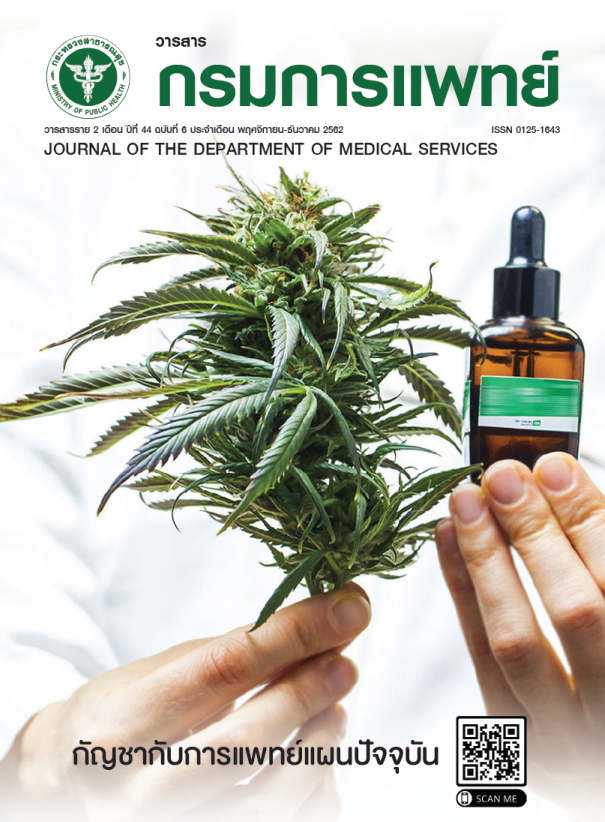Cost–Effectiveness Analysis Comparison of Hysteroscopic Diagnosis with Surgery and Dilatation & Curettage for Diagnosis and Treatment of Abnormal Uterine Bleeding (AUB)
Keywords:
Abnormal Uterine Bleeding, Re-bleeding, Dilatation and curettage, Cost-effectiveness, Hysteroscopic diagnosis and resectionAbstract
A cost-effectiveness analysis of abnormal uterine bleeding (AUB) treatments in comparison of hysteroscopic diagnosis and resection and dilatation and curettage (D&C) aims to study the clinical results and assessed the cost effectiveness of abnormal uterine bleeding (AUB) treatments in comparison of hysteroscopic diagnosis and resection and dilatation and curettage (D&C) at Rajavithi Hospital. The research was conducted among Rajavithi Hospital’s patients during January 1st, 2016 to December 31st, 2016 using Decision Tree model which based on the societal perspective. The results showed that the effectiveness of treatment when followed up at 24 weeks in the group that received dilatation and curettage with no recurrent bleeding was 88.1% meanwhile another group which underwent hysteroscopic diagnosis and resection was 97.7 % (p-value = 0.11). The average cost of dilatation and curettage was higher than that of the hysteroscopic diagnosis and resection equal 329.83 baht. The incremental cost-effectiveness ratio (ICER) of dilatation and curettage compared to hysteroscopic diagnosis and resection was 3,389.83 baht per no recurrent bleeding. Therefore, the conclusion of the study was that hysteroscopic diagnosis and resection providing effectiveness in the treatment of abnormal uterine bleeding not different from D&C in terms of recurrent bleeding. Compared with D&C, hysteroscopic diagnosis and resection was better in some aspects such as more précised and specific, moreover, lower cost of treatment in societal perspective.
References
Shaley M. Jordenk. An epidermiological survey of symptoms of menstrual loss in the community. Br J Gen Pract 2004;54:359-63.
Deligeoroglou E. Dysfucntional uterine bleeding, Ann NY Acad Sci 1997, 816:158-64.
Sulaiman S ,Khaud A, McMillan N. Uterine fibroid; do size and location determine menstrual blood loss. Eur J Obstet Gynecol Reproduc Biol 2004;115:85-9.
Woolcock JG, Critchley HOD, Munro MG, Broder MS, Fraser IS. Review of the confusion in current and historical terminology and definitions for disturbances of menstrual bleeding. Fertil Steril 2008;90:2269-80.
Farquhar C, Ekeroma A, Furness S, et al. A systemic review of transvaginal ultrasonography, sonohysterography and hysteroscopy for the investigation of abnormal uterine bleeding in premenopausal woman. Acta Obstet Gynecol Scand 2003;82:493-505.
Towbin NA, Gviazda IM, March CM. Office hysteroscopy versus transvaginal ultrasonography in the evaluation of patients with excessive uterine bleeding. Am J Obstet Gynecol 1996;174:1678-82.
Hataska H. The evaluation of abnormal uterine bleeding. Clin Obstet Gynecol 2006; 48:258-73.
Riewpaiboon A. Standard cost lists for health technology assessment. [cited 2017 August 16]; Available from: http://www.hitap.net/costingmenu/.
Ministry of Commerce. Report for consumer price index of Thailand. [cited 2017 August 16]; Available from: http://www.indexpr.moc.go.th/price_present/TableIndexG_region.asp?nyear=2559&Province_code=5 &table_n.
Antunes AAR. The efficacy of hysteroscopy in diagnosis and treatment of endometrial pathology. Gynecol Surg 2012;9:47–52.
Litta P, Merlin F, Saccardi C, Pozzan C, Sacco G, Fracas M, et al. Role of hysteroscopy with endometrial biopsy to rule out endometrial cancer in postmenopausal women with abnormal uterine bleeding. Maturitas 2005; 50:117-23.
Ben-Ami I, Melcer Y, Smorgick N, Schneider, Pansky M, Halperin R. A comparison of reproductive outcomes following hysteroscopic management versus dilatation and curettage of retained products of conception International J Obstet Gynecol 2014;127:86-9.
Jansen FW, Vredevoogd CB, Ulzen KV, Hermans J, Trimbos JB, Trimbos-Kemper TCM. Complications of hysteroscopy: a prospective, multicenter study. J Obstet Gynecol 2000;96:266-70.
Moawad NS, Santamaria E, Jonhson M, Shuster J. Cost-effectiveness of office hysteroscopy for abnormal uterine bleeding. JSLS 2014;18:1-5.
Saridogan E, Tilden D, Sykes D, Davis N, Subramanian D. Cost-Analysis Comparison of outpatient see-and-treat hysteroscopy service with other hysteroscopy service models. JMIG 2010;17:518-25.
Downloads
Published
How to Cite
Issue
Section
License
บทความที่ได้รับการตีพิมพ์เป็นลิขสิทธิ์ของกรมการแพทย์ กระทรวงสาธารณสุข
ข้อความและข้อคิดเห็นต่างๆ เป็นของผู้เขียนบทความ ไม่ใช่ความเห็นของกองบรรณาธิการหรือของวารสารกรมการแพทย์



